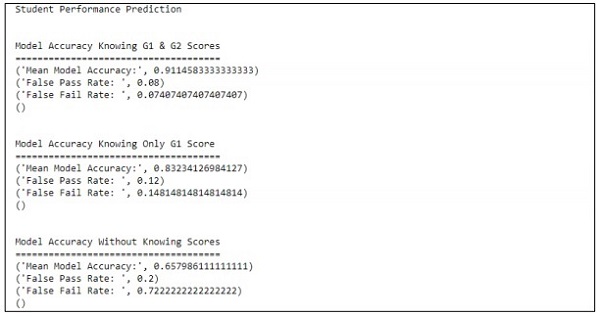예측 성능 향상
이 장에서는 여러 속성이 포함 된 학생의 성과를 예측하는 데 도움이되는 모델을 만드는 데 중점을 둡니다. 초점은 시험에서 학생의 실패 결과를 표시하는 것입니다.
방법
평가 목표 값은 G3입니다. 이 값은 비닝 할 수 있으며 실패 및 성공으로 추가 분류 할 수 있습니다. G3 값이 10보다 크거나 같으면 학생은 시험에 합격합니다.
예
학생의 경우 성능을 예측하기 위해 코드가 실행되는 다음 예제를 고려하십시오.
import pandas as pd
""" Read data file as DataFrame """
df = pd.read_csv("student-mat.csv", sep=";")
""" Import ML helpers """
from sklearn.preprocessing import LabelEncoder
from sklearn.model_selection import train_test_split
from sklearn.metrics import confusion_matrix
from sklearn.model_selection import GridSearchCV, cross_val_score
from sklearn.pipeline import Pipeline
from sklearn.feature_selection import SelectKBest, chi2
from sklearn.svm import LinearSVC # Support Vector Machine Classifier model
""" Split Data into Training and Testing Sets """
def split_data(X, Y):
return train_test_split(X, Y, test_size=0.2, random_state=17)
""" Confusion Matrix """
def confuse(y_true, y_pred):
cm = confusion_matrix(y_true=y_true, y_pred=y_pred)
# print("\nConfusion Matrix: \n", cm)
fpr(cm)
ffr(cm)
""" False Pass Rate """
def fpr(confusion_matrix):
fp = confusion_matrix[0][1]
tf = confusion_matrix[0][0]
rate = float(fp) / (fp + tf)
print("False Pass Rate: ", rate)
""" False Fail Rate """
def ffr(confusion_matrix):
ff = confusion_matrix[1][0]
tp = confusion_matrix[1][1]
rate = float(ff) / (ff + tp)
print("False Fail Rate: ", rate)
return rate
""" Train Model and Print Score """
def train_and_score(X, y):
X_train, X_test, y_train, y_test = split_data(X, y)
clf = Pipeline([
('reduce_dim', SelectKBest(chi2, k=2)),
('train', LinearSVC(C=100))
])
scores = cross_val_score(clf, X_train, y_train, cv=5, n_jobs=2)
print("Mean Model Accuracy:", np.array(scores).mean())
clf.fit(X_train, y_train)
confuse(y_test, clf.predict(X_test))
print()
""" Main Program """
def main():
print("\nStudent Performance Prediction")
# For each feature, encode to categorical values
class_le = LabelEncoder()
for column in df[["school", "sex", "address", "famsize", "Pstatus", "Mjob",
"Fjob", "reason", "guardian", "schoolsup", "famsup", "paid", "activities",
"nursery", "higher", "internet", "romantic"]].columns:
df[column] = class_le.fit_transform(df[column].values)
# Encode G1, G2, G3 as pass or fail binary values
for i, row in df.iterrows():
if row["G1"] >= 10:
df["G1"][i] = 1
else:
df["G1"][i] = 0
if row["G2"] >= 10:
df["G2"][i] = 1
else:
df["G2"][i] = 0
if row["G3"] >= 10:
df["G3"][i] = 1
else:
df["G3"][i] = 0
# Target values are G3
y = df.pop("G3")
# Feature set is remaining features
X = df
print("\n\nModel Accuracy Knowing G1 & G2 Scores")
print("=====================================")
train_and_score(X, y)
# Remove grade report 2
X.drop(["G2"], axis = 1, inplace=True)
print("\n\nModel Accuracy Knowing Only G1 Score")
print("=====================================")
train_and_score(X, y)
# Remove grade report 1
X.drop(["G1"], axis=1, inplace=True)
print("\n\nModel Accuracy Without Knowing Scores")
print("=====================================")
train_and_score(X, y)
main()산출
위의 코드는 아래와 같이 출력을 생성합니다.
예측은 하나의 변수만을 참조하여 처리됩니다. 하나의 변수를 참조하면 학생 성과 예측은 다음과 같습니다.
